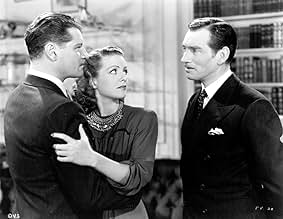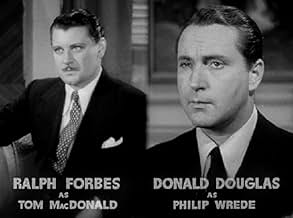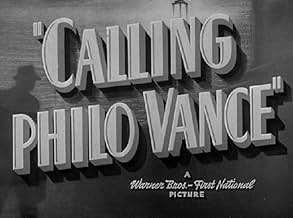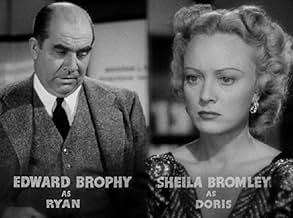Füge eine Handlung in deiner Sprache hinzuDespite an exclusive contract with the U.S. government, designer Archer Coe's design is being bid on by German, Japanese, and Italian agents - until he's murdered.Despite an exclusive contract with the U.S. government, designer Archer Coe's design is being bid on by German, Japanese, and Italian agents - until he's murdered.Despite an exclusive contract with the U.S. government, designer Archer Coe's design is being bid on by German, Japanese, and Italian agents - until he's murdered.
- Regie
- Drehbuch
- Hauptbesetzung
Jimmy Conlin
- Dr. Doremus - Coroner
- (as Jimmy Conlon)
Wedgwood Nowell
- Brisbane Coe
- (as Wedgewood Nowell)
Herbert Anderson
- First Reporter
- (Nicht genannt)
Henry Blair
- Hans Snauble
- (Nicht genannt)
Egon Brecher
- Austrian Judge
- (Nicht genannt)
Empfohlene Bewertungen
This is a remake of the "Kennel Murder Case" with Philo Vance (James Stephenson) going after some U. S. airplane plans sold to a foreign nation; the designer of the plans and his brother both wind up murdered, and there are plenty of suspects.
William Powell was probably the best Philo Vance - he had the requisite charm. Stephenson, who started in films late in life after stage work, was on his way to a big career when he made "Calling Philo Vance" - unfortunately, he died the next year, at the age of 53.
As with "The Dragon Murder Case" with Warren William as Vance, the supporting players have the good lines and the energetic roles. Stephenson doesn't have a lot to work with, but he's okay.
Parts of this film are interesting, it's a little better than "The Dragon Murder Case," which isn't really saying much.
William Powell was probably the best Philo Vance - he had the requisite charm. Stephenson, who started in films late in life after stage work, was on his way to a big career when he made "Calling Philo Vance" - unfortunately, he died the next year, at the age of 53.
As with "The Dragon Murder Case" with Warren William as Vance, the supporting players have the good lines and the energetic roles. Stephenson doesn't have a lot to work with, but he's okay.
Parts of this film are interesting, it's a little better than "The Dragon Murder Case," which isn't really saying much.
One of the weakest Philo Vance films: a pointless remake of "The Kennel Murder Case", with a blander cast. But if you haven't seen "Kennel", you may still find the story ingenious. The then-topical WWII elements look out of place now in a Philo Vance mystery. ** out of 4.
While I do like JAMES STEPHENSON as an actor (he was excellent in THE LETTER with Bette Davis), he lacks the sort of debonair charm needed for the role of Philo Vance in CALLING PHILO VANCE. However, that's not integral to your enjoyment of this updating of "The Kennel Murder Case" which was made in '40 when the Nazis were making big strides during World War II.
Secret stolen plans for a bomber falling into the hands of German agents is the crux of the matter here, to the tune of $250,000. The story begins with Vance accepting an assignment in Vienna where he is trying to find out whether Archer Coe is selling aircraft plans to a foreign country. But the main story begins when he's deported to the U.S., escapes authorities and returns to investigate the case for Chief Investigator Markham (HENRY O'NEILL).
The wealthy household where Coe died in a locked room, is at first ruled as the scene of a suicide but soon evidence proves it to be a murder and there are several suspects--among them, RALPH FORBES, DONALD DOUGLAS and MARTIN KOSLECK, in an unusual role as a butler. Kosleck usually played German spies in all the Warner war films.
Under Stanely Clements' direction, the tale moves quickly to an all too abrupt conclusion with very little explanation given for the intricate murder plot. While not exactly plausible, it does make an interesting mystery for who-dun-it fans with some clever touches in the script.
But the main disappointment lies in not having a satisfactory actor in the Philo Vance role.
Secret stolen plans for a bomber falling into the hands of German agents is the crux of the matter here, to the tune of $250,000. The story begins with Vance accepting an assignment in Vienna where he is trying to find out whether Archer Coe is selling aircraft plans to a foreign country. But the main story begins when he's deported to the U.S., escapes authorities and returns to investigate the case for Chief Investigator Markham (HENRY O'NEILL).
The wealthy household where Coe died in a locked room, is at first ruled as the scene of a suicide but soon evidence proves it to be a murder and there are several suspects--among them, RALPH FORBES, DONALD DOUGLAS and MARTIN KOSLECK, in an unusual role as a butler. Kosleck usually played German spies in all the Warner war films.
Under Stanely Clements' direction, the tale moves quickly to an all too abrupt conclusion with very little explanation given for the intricate murder plot. While not exactly plausible, it does make an interesting mystery for who-dun-it fans with some clever touches in the script.
But the main disappointment lies in not having a satisfactory actor in the Philo Vance role.
This is a very cheaply made and predictable programmer--predictable since its plot is taken, almost verbatim, from two earlier films. It was literally like splicing two old movie together to make a new film!
The first 15 minutes of the film is lifted right out of PRIVATE DETECTIVE 62 (1933--starring William Powell), though the hero was stealing information from a French safe in the original film and in CALLING PHILO VANCE it involved stealing from an Austrian one. In both, he was working for the state department (though they denied this) and in both cases he was deported back to the US--only to have the boat's captain be told to return the man just as they are pulling into New York harbor--at which point the man jumps overboard and the rest of the film begins. It's so exact that they are practically the same film in the first reel.
Following this narrow escape, the plot is THE KENNEL MURDER CASE (also starring Powell). I am sure of this because I just saw both 1930s films in the last month. In fact, in many places it was word-for-word the same--so much so that I couldn't stand watching the film again--especially because James Stevenson on his best day doesn't even come close to the charm and style of William Powell's version of Philo Vance. It's like having Lee Majors play the lead in High Noon instead of Gary Cooper (this DID happen) or Timothy Dalton play "Rhett Butler" instead of Clark Gable (this, sadly, also DID happen)!! So, unless you've never seen the near-perfect KENNEL MURDER CASE (which earned a well-deserved 9 from me), don't even bother with this by-the-numbers re-make. It just isn't worth your time. And, for that matter, PRIVATE DETECTIVE 62 is also quite superior to CALLING PHILO VANCE. In fact, just WHO is this James Stevenson and why is he stealing from William Powell?!
The first 15 minutes of the film is lifted right out of PRIVATE DETECTIVE 62 (1933--starring William Powell), though the hero was stealing information from a French safe in the original film and in CALLING PHILO VANCE it involved stealing from an Austrian one. In both, he was working for the state department (though they denied this) and in both cases he was deported back to the US--only to have the boat's captain be told to return the man just as they are pulling into New York harbor--at which point the man jumps overboard and the rest of the film begins. It's so exact that they are practically the same film in the first reel.
Following this narrow escape, the plot is THE KENNEL MURDER CASE (also starring Powell). I am sure of this because I just saw both 1930s films in the last month. In fact, in many places it was word-for-word the same--so much so that I couldn't stand watching the film again--especially because James Stevenson on his best day doesn't even come close to the charm and style of William Powell's version of Philo Vance. It's like having Lee Majors play the lead in High Noon instead of Gary Cooper (this DID happen) or Timothy Dalton play "Rhett Butler" instead of Clark Gable (this, sadly, also DID happen)!! So, unless you've never seen the near-perfect KENNEL MURDER CASE (which earned a well-deserved 9 from me), don't even bother with this by-the-numbers re-make. It just isn't worth your time. And, for that matter, PRIVATE DETECTIVE 62 is also quite superior to CALLING PHILO VANCE. In fact, just WHO is this James Stevenson and why is he stealing from William Powell?!
This remake of Kennel Murder Case, The (1933) has some good points, but James Stephenson is not one of them. He plays it too impersonal for my taste and pales by comparison with William Powell, who played Vance in the original. But the screenplay, which was updated for the war that loomed on the horizon, was nicely developed, concerning plans for a warplane. The setting was switched to the State Department, with Vance an employed investigator instead of a private eye. I really enjoyed how he used diagrams to explain the movement of the people involved in the murder of the warplane designer, so that in the end, the actions of all were clear. The film also had the advantage of having Edward Brophy in the Sergeant Heath role (here he's called Ryan), bringing comedy without the stupidity of the Heath character. It was rather fun to watch.
Wusstest du schon
- WissenswertesAll the scenes involving the two murdered men are taken directly from the earlier mystery called The Kennel Murder Case (1933), in which William Powell played Philo Vance. In both movies, most of the dialog in the scenes pertaining to the murders and the investigation is exactly the same, word-for-word, which clearly indicates that the script from the 1933 film was adapted to the story for this film, which focuses on the theft of secret aircraft plans. However, in "The Kennel Murder Case", the plot concerns stolen Chinese art objects.
- PatzerRalph Forbes is credited onscreen as "Tom MacDonald," but throughout the film, he is called Taylor MacDonald.
- Zitate
Dr. Doremus - Coroner: [about the dead Archer Coe] There couldn't have been much of a struggle. His hair isn't even mussed.
Ryan: [Sardonically] Somebody must have blackjacked him and then combed his hair.
- VerbindungenFeatured in Inside the Dream Factory (1995)
- SoundtracksI'm Happy About the Whole Thing
(uncredited)
Music by Harry Warren
Played when Vance and Ryan meet Grassi in the bar
Top-Auswahl
Melde dich zum Bewerten an und greife auf die Watchlist für personalisierte Empfehlungen zu.
Details
- Erscheinungsdatum
- Herkunftsland
- Sprachen
- Auch bekannt als
- Tres horas trágicas
- Drehorte
- Produktionsfirma
- Weitere beteiligte Unternehmen bei IMDbPro anzeigen
- Laufzeit1 Stunde 2 Minuten
- Farbe
- Sound-Mix
- Seitenverhältnis
- 1.37 : 1
Zu dieser Seite beitragen
Bearbeitung vorschlagen oder fehlenden Inhalt hinzufügen

Oberste Lücke
By what name was Calling Philo Vance (1939) officially released in India in English?
Antwort






















